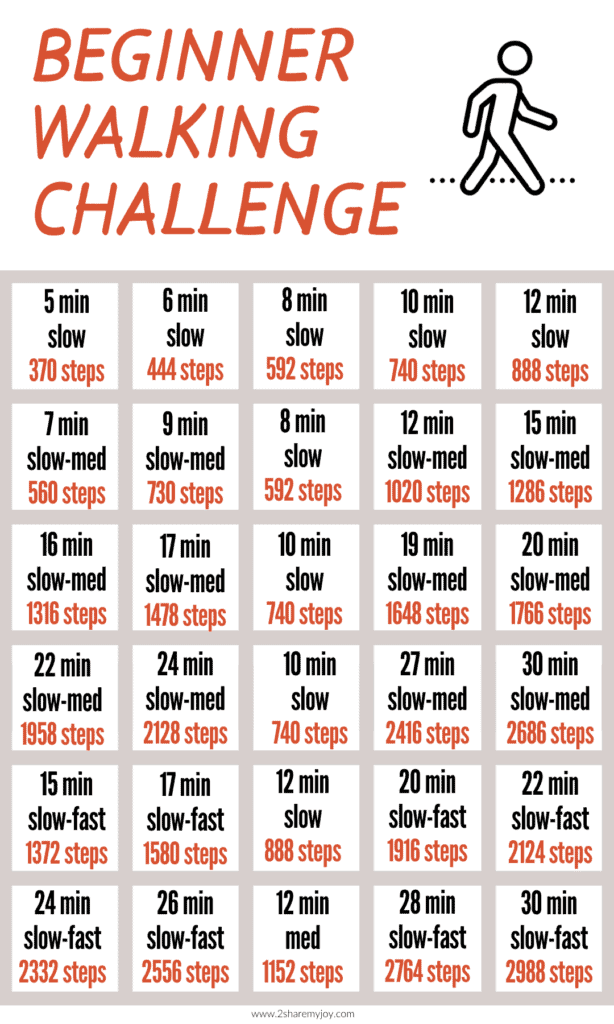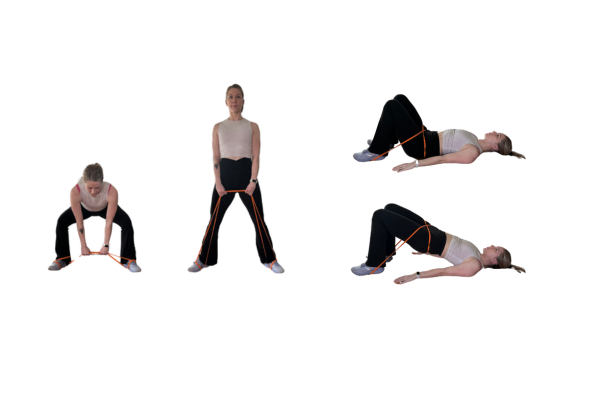Walking Challenge for Beginners
The 30-Day Walking Challenge is here to guide you, designed with beginners in mind who may have little to no prior walking experience.
Whether you’re recovering from surgery, injury, or living a sedentary lifestyle, this challenge offers a great starting point.
Before you dive in, consult your physician to ensure the walking challenge is a suitable fit for you. With 30 days and 30 distinct walking patterns, all you need are a pair of earphones and the determination to follow along.
The challenge is thoughtfully structured with intervals set at slow, medium, and fast walking paces.
From just 5 minutes of slow walking on day one to 30 minutes of mixed-intensity walking on day 30, the journey unfolds gradually.
You can screenshot the infographic or follow along in the app. Here is a quick app preview:
Each day introduces small challenges to enhance your endurance. If you find the challenge too easy, you can skip ahead, increase your stride length, or incorporate ankle and wrist weights for added intensity.
But the benefits of this challenge extend beyond physical health. Discover how walking can burn calories, improve metabolism, and contribute to cardiovascular health.
Learn about its gentle, joint-friendly nature, making it suitable for individuals of all fitness levels and ages.
This article will provide valuable insights into the 30-Day Walking Challenge, how to follow it, and its potential benefits, helping you embark on a journey toward better health and fitness.
What is the 30 day walking challenge?
The walking challenge is designed for beginners who do not walk much or at all. It is a great starting point to become physically active if you have recently had surgery, an injury, or if you are very sedentary.
Please consult your physician to ensure that the walking challenge is suitable for you.
There are 30 days with 30 different walking patterns. Simply put your earphones in, hit start, and walk to the beat.
I have edited the walking beat for different intervals: slow, medium, and fast.
I used this paper as a guide and made the three different intervals. Slow walking is 74 steps per minute, medium speed is 96 steps per minute, and fast walking is 112 steps per minute.

Day one consists of only 5 minutes of slow walking, and by day 5, you’ll be walking slowly for 12 minutes. The time, intensity, and step count increase gradually.
For example, on day 6, you start with 7 minutes of interval walking for 7 minutes. The starting intervals are at slow and medium speed.
By day 20, you will walk for 30 minutes with slow to medium intervals. On day 21, you will reduce the time but introduce fast walking intervals.
Day 30 involves a mix of slow, medium, and fast intervals, and you’ll walk for 30 minutes. Rest days are included in the schedule.
On rest days, you still walk but for a shorter duration and at a slower pace compared to the surrounding days. If you feel energized and prefer not to rest, go ahead and simply repeat the previous day’s routine.
You can do this challenge indoors, in your yard, outside, or on a treadmill.
Once you complete the walking challenge, you can choose to repeat it with ankle weights to increase the intensity or consider joining a more advanced walking challenge.
What if this walking challenge is too easy for me?
To make the challenge more intense, walk with larger strides (bigger steps), add ankle and/or wrist weights, or use a walking route with hills.
If you do the walking challenge on the treadmill you can incline your treadmill.
How many steps will this waking challenge add to my daily step count?
On day one, 5 minutes of slow walking will add approximately 370 steps. By day 10, you will accumulate 1286 steps, and on day 15, you’ll increase it to 1766 steps. Day 20 will contribute 2682 additional steps, and by day 30, you’ll be adding almost 3000 steps!
The number of steps you’ll accumulate will be displayed in each daily video on the app.

Can I lose weight by walking 30 minutes everyday?
Walking is an excellent way to burn extra calories throughout the day. Simply incorporating 10-minute walks here and there can have a significant impact on your weight loss efforts.
Walking is also effective in raising your heart rate and increasing your weekly active minutes. In fact, some walks can burn more calories than a weightlifting session.
Physical activity plays a significant role in weight maintenance. While walking is excellent for weight loss, it’s even more valuable for maintaining your weight loss.
When using walking as a tool for weight loss, it’s crucial to progressively increase intensity each week to prevent hitting a weight loss plateau.
You want to challenge your body to ensure your metabolism doesn’t adapt to your routine.
The follow along walking challenge is already made to increase intensity daily over the course of 30 days.
How to do the 30-day walking challenge
You can screenshot or print the walking challenge infographic and easily follow along.
However, for a more precise and steady improvement in your walking tempo and overall performance, I recommend following the walking challenge within the app.
In the app, you’ll find the intervals presented in step-by-step videos with accompanying music.
Simply hit play and step to the beat, which is tailored to the specific speed, ensuring you maintain the correct time and interval. Each day introduces a small challenge to help you steadily enhance your endurance.
You can sign up for the app and access the walking challenge for a 7-day free trial. Additionally, the app offers a wide variety of other creators and workouts.
Tips for starting the walking challenge
Make sure you have received clearance from your physician before starting this new activity. It’s essential to ensure you have appropriate clothing and comfortable walking shoes.
Drinking an adequate amount of water before and after your walk is crucial for staying hydrated.
I also recommend incorporating stretching into your routine before and after your walk. A comprehensive full-body stretching routine after the walk and a quick, active stretching session before starting can be beneficial.
If you find the initial stages of this challenge too easy, you have the option to skip days or even advance a few weeks ahead. You can also intensify your workout by increasing your stride length, taking larger steps.
To make your walking routine more challenging, consider adding ankle and wrist weights or walking uphill. If you’re using a treadmill, adjust the incline on your machine accordingly.
You can also try this challenge on a stairmaster or elliptical machine.
Select a time of day that best suits your walking routine and, if needed, set a reminder approximately 15 minutes beforehand to prepare. The walking challenge in the app provides a scheduling tool as well.
Benefits of walking everyday
Walking may not seem as intense as high-intensity interval training or weightlifting, but it can help you burn calories consistently.
The number of calories burned while walking depends on factors like your walking speed and body weight, but a brisk walk can burn around 300-400 calories per hour. Over time, this calorie deficit can lead to weight loss.
Walking is gentle on your joints, making it an ideal exercise for individuals of all fitness levels and ages.
Unlike activities that put stress on your knees and hips, like running or jumping, walking minimizes the risk of injury. This means you can maintain a consistent exercise routine without overexerting your body.
Regular walking has been shown to boost your metabolism, which is essential for weight loss.
Walking at a brisk pace elevates your heart rate and contributes to cardiovascular health. A strong heart can pump blood more efficiently, improving circulation and oxygen delivery to your muscles. This can aid in better workout performance and overall well-being.
It is also an excellent stress-reliever, as it triggers the release of endorphins, which are natural mood lifters.
Walking after a meal can aid in digestion and reduce bloating. A leisurely stroll after eating helps your body process food more effectively, potentially preventing overeating in subsequent meals.
One of the biggest advantages of walking every day is its sustainability. You don’t need any special equipment or a gym membership, and it’s an activity that can be easily incorporated into your daily routine.
This makes it much easier to maintain in the long run, increasing the likelihood of successful weight loss and weight maintenance.
Walking can be a social activity. Invite a friend or family member to join you, which can provide motivation and strengthen your bond.
Additionally, walking in a natural setting can have a calming effect, reducing stress and improving overall mental well-being.








